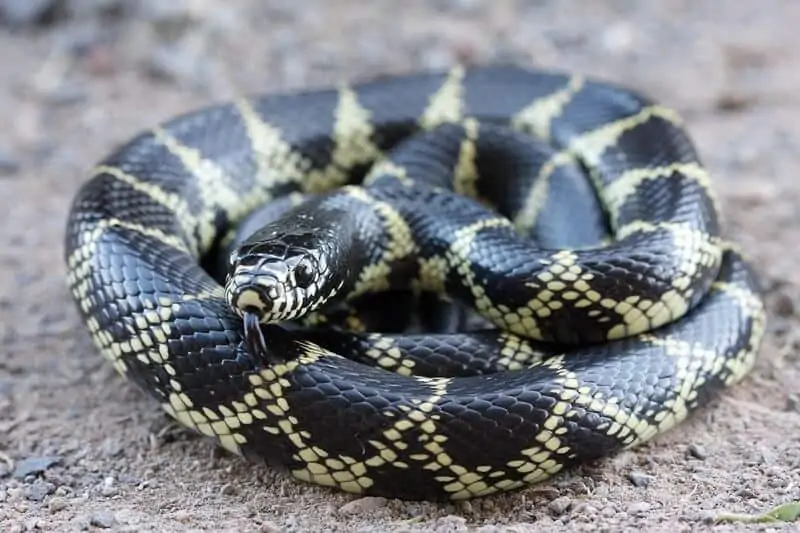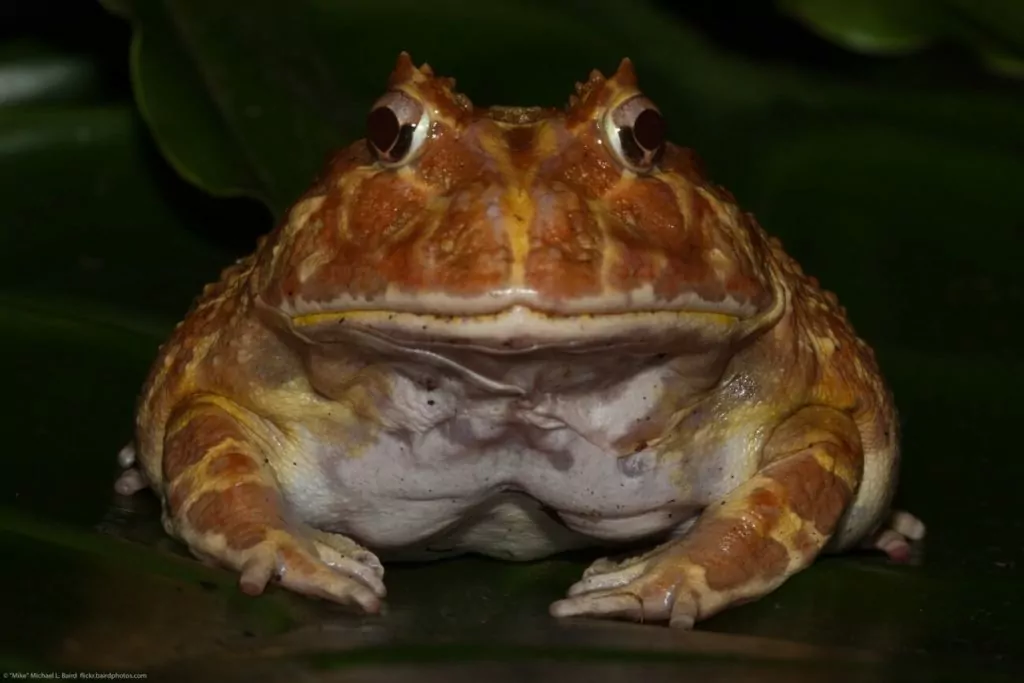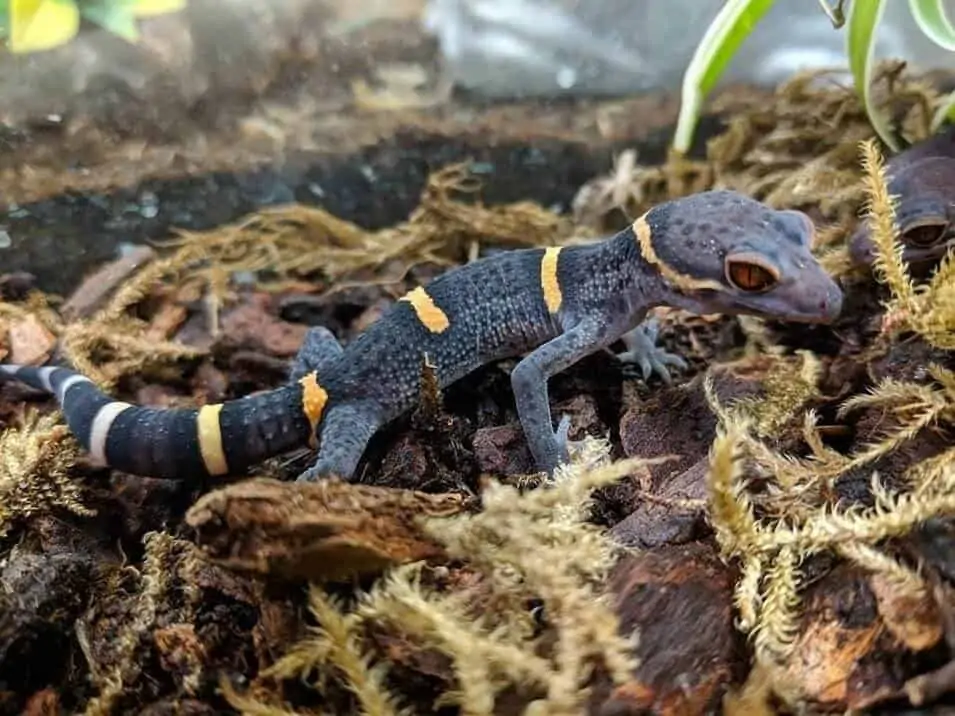Desert kingsnakes are lovely reptiles that can make great pets. On top of that, they’re very beginner-friendly!
This guide will cover everything you need to know about desert kingsnake care, so you can be sure yours will thrive.
Table of Contents
Species Summary
The desert kingsnake (Lampropeltis splendida) is a non-venomous, North American constrictor that can be found in parts of Arizona, Texas and New Mexico. Its somewhat easy-going nature and fairly simple care requirements make this a great pet snake for beginners.
Despite its name, this particular kingsnake doesn’t live in a desert environment. Instead, it can be found in areas around rivers, streams, water tanks and other sources of water.
In a weird sort of twist that only nature can provide, the non-venomous desert kingsnake often eats young, highly poisonous diamondback rattlesnakes. Even adult diamondbacks will think twice before tangling with a desert kingsnake.
Appearance & Colors
The desert kingsnake may not be the most colorful snake out there, but its dark brown body and yellow or white crossbars make a striking and interesting contrast. No two desert kingsnakes are alike, so their patterns are as unique as fingerprints or the stripes on a zebra.
Expert Tip: Even though males and females have the same coloration, female desert kingsnakes are always slightly larger than males.
Lifespan
The desert kingsnake is an excellent choice for anyone who is looking for a snake that has the potential to provide years of enjoyment and enrichment. While the lifespan of the desert kingsnake in the wild is pretty difficult to determine, the lifespan of a desert kingsnake in captivity is usually between 12 and 20 years.
Of course, this is just an average lifespan range, and there are many factors that come into play. With a proper diet and a clean and well-maintained enclosure, the chances are very high that you and your desert kingsnake will have a long lasting and fulfilling relationship.
Average Size
Compared to many pet snakes, the desert kingsnake is considered to be on the smaller side. On average, an adult desert kingsnake will grow to around two to five feet long.
Some of these kingsnakes may grow to be slightly longer, but most desert kingsnakes won’t exceed the high end of this range. Hatchlings are usually around eight inches long.
Desert Kingsnake Care
Because of their fairly docile nature and relative ease of care, desert kingsnake care is often considered to be suitable beginners. That being said, this snake still requires a specific enclosure size, a consistent level of humidity, an appropriate thermal gradient and a healthy diet.

You’ll also need to provide plenty of enrichments, places to hide and a supply of fresh, clean water. While all of this may seem overwhelming at first, it won’t take long to get into a daily care routine.
A little research and some advanced planning will help to ensure that you give your desert kingsnake the best care possible.
Enclosure Size & Dimensions
Choosing the right enclosure size for your desert kingsnake is a critical first step.
The absolute minimum size of the enclosure for an adult desert kingsnake is 30 gallons. This translates to about 40 inches long and 18 inches high.
If you can manage a larger enclosure, then we highly recommend doing so. Your kingsnake will enjoy having the space to slither around and explore the whole of its enclosure without feeling cramped or closed in.
If you have juveniles or hatchlings, then they’ll be fine in a ten gallon enclosure until they are ready for a larger one.
When you are choosing an enclosure for your desert kingsnake, make sure that you get one with a very secure lid that can be locked in place. Your snake will try to get out of the enclosure at every opportunity, so providing an enclosure that is escape-proof is absolutely critical.
What To Put In Their Habitat
The habitat setup is one of the most important aspects of desert kingsnake care. The right substrate, enrichments and decorations can be the difference between a well-adjusted snake and one that’s lethargic, unhappy, and more prone to illness.
The first thing to go into the enclosure is the substrate. The desert kingsnake likes to burrow, so you’ll want to provide a substrate that’s nice and soft and comfortable. We recommend using something like cypress mulch or aspen-based bedding. Sphagnum moss can be added to help with moisture retention. However, cedar or pine bedding should never be used because the oils in these substrates are not safe for your kingsnake.
Expert Tip: Some people use newspaper or paper towels, but we feel that something more natural is better for the snake. Don’t be tempted to use small rocks or pebbles in the enclosure because they are a choking hazard.
Because your kingsnake is a burrower, we suggest placing at least three inches of substrate in the enclosure. Spot clean the substrate every day and replace it at least once a month.
If you have a desert kingsnake, there is a good chance that it was caught in the wild. This is why it’s important to create an enclosure that’s as close to the snake’s natural habitat as possible. Choosing the best enrichments and decorations can be lots of fun, and many pet owners get quite creative.
What are some of the things that can be placed in your desert kingsnake’s habitat? Items, such as large rocks, logs, branches and artificial plants, are excellent enrichment pieces that stimulate curiosity, provide climbing opportunities and help to hold in humidity.
Due to this snake’s shy nature, it’s going to need plenty of places to hide. You can purchase hides at any pet store, or you can make them out of plastic bowls or cereal boxes. One of these hides should be lined with moss to create a “humid” hide.
Temperature
Because desert snakes are not able to regulate their own body temperatures, it’s going to be up to you to create a temperature gradient within the habitat. This means that one part of the enclosure should be set up as a cool area and one as a hot, basking area. Only about one-third of the enclosure should be set up as a hot zone, and the rest of the tank needs to be kept on the cooler side.
Temperatures in the cool area should be maintained at 80 degrees Fahrenheit during the day and between 68 and 75 degrees at night. The hot area, however, needs to stay at a toasty 90 degrees.
A basking lamp can be placed over the area dedicated for basking, or you can put a heating mat under the hot side of the tank. We recommend a basking lamp for best results.
Lighting
While desert kingsnakes don’t require supplementary UVB lighting, we suggest exposing them to some extra UVB lighting anyway. Most of the time UVB lighting is used to ensure a sufficient supply of Vitamin D, but your desert kingsnake will get all of the vitamins it needs from its prey. However, using an appropriate kind of UVB lighting will mimic the snake’s native desert sunshine.
Fluorescent lamps can be used to create a more natural sense of day and night, but while recommended, this is not completely necessary.
Humidity
Maintaining the correct level of humidity within the enclosure is an important part of desert kingsnake care.
You’ll want to make sure that the humidity level remains between 50 and 75 percent at all times. Placing a hygrometer and checking it daily is the best way to ensure that the level of humidity stays within range.
Why is a proper humidity level so important to your desert kingsnake? If the humidity is too low, your snake may have trouble with shedding. Conversely, too much humidity may cause respiratory infections or skin sores.
Desert kingsnakes need extra humidity during periods of shedding, so if you notice that your snake is going through this process, it’s a good idea to keep the humidity at 75 percent.
Expert Tip: How can you create humidity inside the enclosure? Misting the tank once a day with clean water and placing a large bowl of fresh water in the enclosure should be enough to maintain proper levels.
Water
Your desert kingsnake doesn’t require anything fancy or complicated when it comes to water. A large, sturdy and spill-proof plastic bowl full of fresh, clean water is all it’s going to need. That being said, we think that it’s very important to make sure that the water in the bowl is filtered and free of chemicals such as chlorine and chloramines. Some pet owners choose to boil spring water or use collected rainwater, but filtered tap water is totally fine.
Ideally, the water in the bowl should be changed every day, and the bowl itself needs to be thoroughly scrubbed and cleaned every week. However, if your desert kingsnake decides to go to the bathroom in the bowl, or if you notice that it’s looking sketchy, then clean it and replace the water right away.
What size bowl should you use? It should be big enough for the snake to be completely submerged. This is especially important during periods of shedding because overly dry skin can lead to serious health issues.
Food & Diet
In the wild, desert kingsnakes eat a variety of things such as eggs, birds, small mammals and other snakes. However, your kingsnake in captivity will be perfectly happy with a diet of frozen and defrosted mice. It’s never a good idea to place live prey in your snake’s enclosure. Frightened prey may bite or scratch your snake.
In general, you’ll want to feed a young snake one pinkie mouse every four days, and an adult snake can be given a full-sized mouse every seven days. When choosing a mouse to feed your desert kingsnake, make sure that it is around the same size as the width of your snake.
After you pick out your mouse and defrost it, you only need to place it inside the enclosure. Your snake will do the rest. If your desert kingsnake seems shy about eating, then you may want to feed it at night or let it take the prey into one of its hides.
Expert Tip: Unlike some other snakes, the desert kingsnake doesn’t require supplemental vitamins. A regular diet of mice will give your snake all of the nutrition it needs.
Potential Health Issues
Desert kingsnakes are fairly robust snakes, but some health issues are sure to come up at some point during its lifetime. Most common kingsnake health problems are easy to cure, but if left untreated, they may become severe.
Let’s take a look at a few of the problems you may encounter as a kingsnake caretaker.
Obesity
Obesity is probably not your first thought when it comes to snake health issues, but it can be a real problem. Desert kingsnakes will eat whatever you put into their enclosure, so if you feed them too much or too often, they are going to eventually become overweight. As with humans, obesity in snakes can cause a wide range of long-lasting health problems.
You can help your snake to stay healthy and trim by providing plenty of things to climb on and by feeding them an appropriate diet.
Shedding Issues
Shedding can be a difficult time for a desert kingsnake. If the atmosphere in the enclosure is too dry, or if your kingsnake doesn’t have a place to submerge in water, then it may experience partial shedding. Partial shedding can be quite painful and may create hardened, dry patches.
Providing plenty of fresh water and maintaining a humidity level between 50 and 75 percent will help to prevent problems with shedding.
Parasites
Parasites, such as snake mites or ticks, can be a real problem once they become established in the enclosure. If you notice that your desert kingsnake is spending more time than usual in its water bowl, and you see little black dots floating in the water, then there’s a good chance that your kingsnake has parasites.
Once the parasites get under a snake’s scales, they will begin to cause intense itching and irritation. Some parasites carry diseases, so you’ll want to get a handle on the problem as soon as possible.
If you think that your reptile is suffering from parasites, then you’ll need to thoroughly clean the entire enclosure and all of the toys and decorations. Then your desert kingsnake will need to be treated with a topical cream. Your veterinarian will be able to guide you to the correct treatment.
Respiratory Problems
There are a few things that can make your desert kingsnake more susceptible to respiratory infections: a dirty enclosure, poor ventilation, and a humidity level that’s too high. Respiratory infections can be very serious, so it’s critical that you do everything you can in order to keep your snake’s environment clean and regulated.
Some signs of a respiratory infection include lethargy, ragged breathing, nasal discharge and lack of appetite. Take your snake to the vet right away if a respiratory infection is suspected.
Mouth Rot
This last issue can be particularly nasty. If you notice pus coming from your desert kingsnake’s mouth or nose, dead tissue around the sides of the mouth, lethargy, a lack of appetite or an inflamed area around the mouth, you’ll want to get your snake checked out by a veterinarian. Mouth rot is usually caused by a bacterial infection, and antibiotics are often required.
Behavior & Temperament
Unlike some snakes, the desert kingsnake is not known to be aggressive or snippy. However, it will bite if it feels threatened or thinks that your hands are prey. This snake’s other response to fear or stress is something called musking. Musking is when certain snakes release a smelly substance from their anuses, and this is something that you definitely want to try to avoid.
Sometimes, especially in the wild, a desert kingsnake will pretend to be dead in order to escape predators or humans. They do this by flipping onto their backs and becoming completely still.
The desert kingsnake is a solitary, shy snake that is happiest being by itself in an enclosure that offers plenty of places to hide. Providing it with lots of quiet places to hang out will make your kingsnake feel safe and content.
In the wild, desert kingsnakes are usually terrestrial snakes, but they do enjoy climbing and exploring any logs, large rocks or branches that you put into its enclosure.
Your desert kingsnake may exhibit diurnal, crepuscular or even nocturnal behavior. When your kingsnake is most active is usually dependent on the temperature inside and outside the enclosure.
Handling Them
Desert kingsnakes don’t enjoy being handled for long periods of time, but they can be trained to at least tolerate brief handling sessions. This is going to take time and patience, but the result will be a snake that you can remove from the enclosure without harm to you or the kingsnake.
Kingsnakes are not big fans of loud noises or sudden movements, so all handling should be done in a quiet, stress-free area where there are no pets or children. If your snake becomes startled it may musk or bite out of fear.
To get your desert kingsnake used to you, start off by simply placing a clean hand into the enclosure for a few seconds. This will get your snake used to your scent and to the idea of having your hand in its territory.
When you feel that you’re both ready, place one hand behind the head and another under its body. Gently remove your snake from the enclosure, making sure that it feels safe and supported. Each time that you take your snake from its enclosure, you can increase the amount of time that you hold it. However, never keep it out for more than 10 or fifteen minutes at a time.
Put your desert kingsnake back into its enclosure right away if you sense that it’s afraid or stressed in any way.
Desert kingsnakes, like all snakes, have the potential to transmit salmonella to humans. It’s very important to wash your hands after handling your snake or touching the enclosure.
Conclusion
Desert kingsnake care can be managed by just about anyone. These reptiles are easygoing and low-maintenance.
If you have any questions about the information in this guide, let us know. We’re always happy to help!


